I’m so happy to have the opportunity to introduce Floret readers to Gracielinda Poulson from Grace Rose Farm as part of a Farmer & the Florist Interview. If you aren’t already familiar with Grace Rose Farm, you’re in for a real treat!
Gracie’s story is simply remarkable. What started as a few social media posts from a backyard hobby garden has exploded into one of the fastest growing local flower businesses in the country.
In addition to growing thousands of exquisite garden roses for florists, Grace Rose Farm also sells potted roses via their online shop, offers on-farm workshops, a new rose-infused skin care line and plans to offer public tours.
Located in Santa Ynez, California, Grace Rose Farm specializes in rare and old fashioned garden roses that are lovingly and organically grown. In their nursery you’ll find antique garden roses, English shrub roses, cold climate roses, and roses with the very best blush, pink, peach, white and coffee toned colors. While most other suppliers sell bareroot plants, Grace Rose Farm ships two year old plants in three gallon nursery pots that are ready to transplant and thrive in your own garden. Whenever I see Gracie’s photos on Instagram, I can’t help but want to add more varieties to my own rose patch.
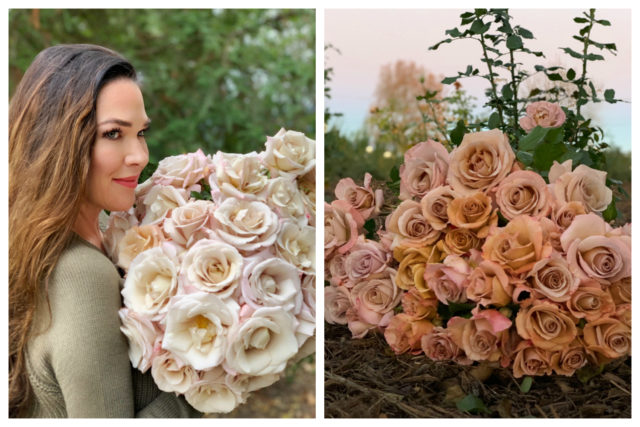
Erin: Gracie, thanks so much for taking time to share your story with Floret readers. When I recently asked Instagram followers to name some of their favorite farms they follow, it was no surprise to see Grace Rose Farm listed as one of the most loved. For those not familiar with your story, can you share a little more about yourself and your farm?
Gracie: I’ve been a lifelong gardener who took my roses with me every time I moved. I grew up helping my grandma and uncle in their beautiful rose gardens and have always related to roses from within. I was that person with a 50 square foot New York City balcony covered in potted roses who would drag them inside in December and cram my apartment with them! In January 2016, my husband and I bought our first home that sat on a half acre where I was finally able to plant dozens of roses that had previously lived in pots.
In the winter of 2016, we planted 500 more roses in our backyard, and florists quickly found out about my roses through Instagram. It was never my intention to sell cut roses, but as more florists asked for them, I began thinking it could be a fun hobby. I was completely unaware of the slow flower movement and what I had perhaps stumbled upon. I have a marketing and graphic design background and at the time still flew 100,000 miles per year around the country to consult with clients. I didn’t have a lot of downtime, but when I did, it was with my roses.
As 2016 went along, we planted more and more roses, and by fall of that year we were cutting 2,000+ roses each week and providing them to around 200 florists across the country. In November 2016, I decided growing roses was something I was interested in doing on a larger scale, so we leased two acres of farmland nearby, and I let go of my marketing clients. We then purchased and planted an additional 5,000 roses for our new leased farmland, which was used previously for vegetable production.
We found our roses grew wonderfully there, and our production increased to 10,000-15,000 stems per week. About halfway through our 2017 season, we found ourselves always short roses and turning away business. By this time we were working with 500+ floral designers, and I was the only person cutting roses. Additionally, our cold storage, processing and packaging was done 15 minutes away at our home, so our life was chaotic. It was at this time when we began thinking about purchasing our own farm. We didn’t want to lease more land and then have to move our roses. Roses, like trees, should be planted with permanency in mind so the thought of moving even the 5,000 roses we already had was daunting, but we knew if we could find the right land, we needed to move sooner than later so we could scale up and meet demand.
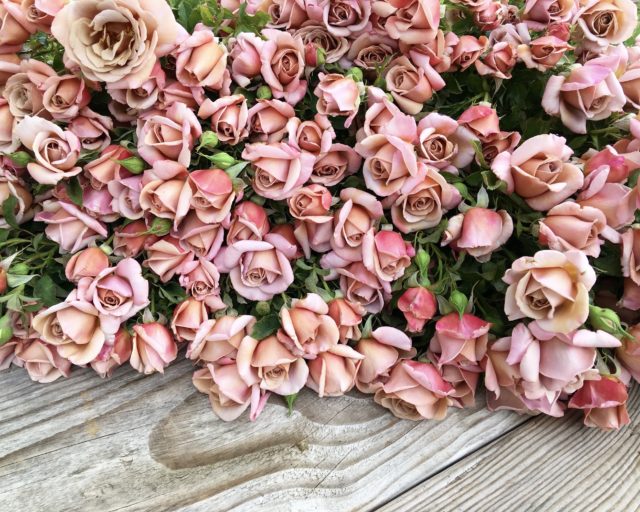
Erin: You scaled up in a big way! Can you share more about the process of expanding your production?
Gracie: In August of 2017, we began looking at 10-20 acre properties in southern California. I ordered an additional 15,000 roses that fall while we were looking for a new farm with the hope that we would find something. We ended up putting an offer on the first property we looked at in Santa Ynez because it fit most of our needs, and coincidentally the day we made an offer, we also got a full price cash offer on our home, so we knew it was meant to be! The only drawback to the property was it was an equestrian property, as most are in the area, and every building and outdoor space was designed for horses. The front six acres would be home to 20,000 roses, and we very quickly had to tear out 12 horse pastures.
We went to work on the pastures so we could transplant our 5,000 roses from our previous farm. The transplant season is very, very short here because it never freezes, which means roses don’t go fully dormant.
Erin: I know a lot of readers are interested in the process of converting pasture land to flower production. Would you mind talking a little about how you prepared the soil?
Gracie: We hired a farmer with large tractors to plow, rip, till and disc our pastures. In hindsight, we should have tried to kill the grass before just tilling it. All the grass grew back immediately and caused so much stress for us and our roses. My best advice for anyone looking to turn pastures into flowers is to give yourself time. In most areas that means an entire season, otherwise the grass will haunt you for months or years. We didn’t have the luxury of time because we couldn’t manage two farms that were two hours from one another. If we ever expand, I will give myself time to get the soil completely free of grass before planting roses!
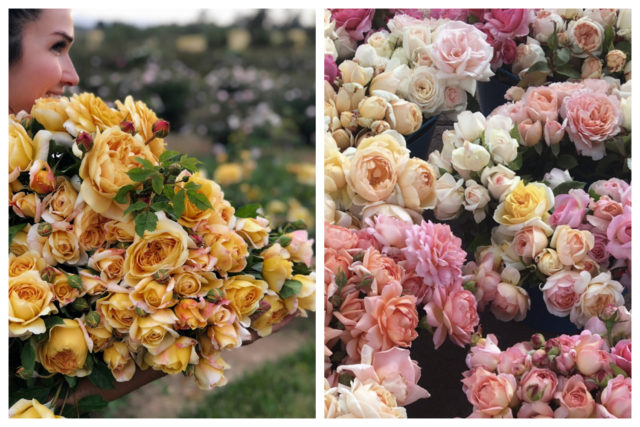 Erin: The pictures of your roses practically take my breath away. What are a few of the varieties that you can’t grow enough of?
Erin: The pictures of your roses practically take my breath away. What are a few of the varieties that you can’t grow enough of?
Gracie: Well thank you…that’s so kind! We grow around 1,800 Koko Loko and 2,000 Distant Drums, and there are never enough. Even with our vigorous disbudding and bloom cycle manipulation, we never have as many as everyone wants. Lately the demand for the muted mustard/brown tones has grown, so I’ve had to identify roses I want to grow and propagate them with permission from the patent owner as they’re not commercially available. We’re growing Stephen Rulo, Julia’s Rose, Connie’s Sandstorm, Butterscotch and Honey Dijon in very large quantities for 2019 to hopefully meet demand! Of course the creamy tones are always also in high demand – Lichfield Angel and Pure Perfume to name a few; and blush/peach are always popular. David Austin’s beloved Evelyn is and will always be the rose that fills the need for peachy/blushy tones. I have a collection of nearly 1,000 Evelyns now and wouldn’t trade them for anything!
Erin: Many Floret readers have expressed that they’d like to learn how to successfully grow garden roses. What advice do you have for them–especially for those that garden in other growing zones?
Gracie: I think the best advice I can give is to purchase plants that have a high likelihood for success in your growing area. Here in California we can grow everything because our climate is mild, but that’s not the case everywhere. I hear time and again that someone’s bare root rose in zone 6 died from die back or never took off. Then I ask what rose it was and they name a rose that’s suitable for zones 7-10. All of the roses in our nursery, and most nurseries, are sorted by zone, so be sure to pick a rose that’s going to thrive where you live. Also, a huge part of rose gardening is being proactive. No matter whether you have one or one thousand roses, pests and disease will come. If you want perfect roses and don’t want to deal with pests or disease, don’t grow roses. Some roses are more disease resistant than others, and that information is generally provided by the nursery.
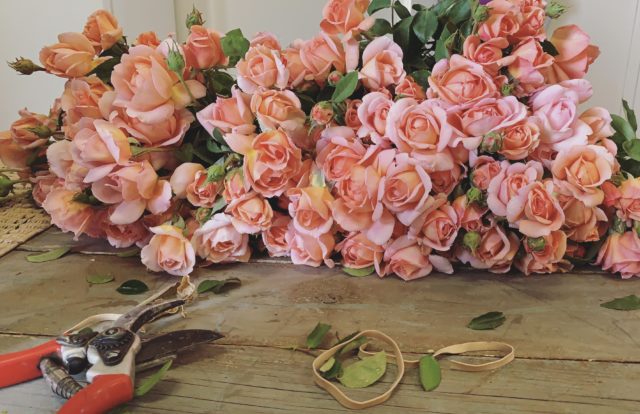 Look for roses that are disease resistant so you don’t have to spray. Being a proactive rose gardener means providing the rose with what it needs before things go wrong.
Look for roses that are disease resistant so you don’t have to spray. Being a proactive rose gardener means providing the rose with what it needs before things go wrong.
Erin: For those not familiar with your process of producing and “budding” garden rose plants, can you share a brief insight as to what is involved?
Gracie: Like most things in my life, I want things that don’t exist somewhere for me to buy. That’s how our nursery and “budding” roses started. Once I saw the demand for our cut roses, I was immediately convinced that I needed to introduce different roses to the cut flower market. I’ll be honest, I get bored of producing the same old thing that other growers also have and I love the idea of having rose varieties that are unique to us. This is when I decided to take my collection of antique and rare roses, grow them out and then produce new plants from them. Many rose growers take cuttings from plants, root them and then they have a new plant. That method is great if you want one or two plants, but when you want to produce hundreds of new plants and only have one plant to start with, you need to get creative.
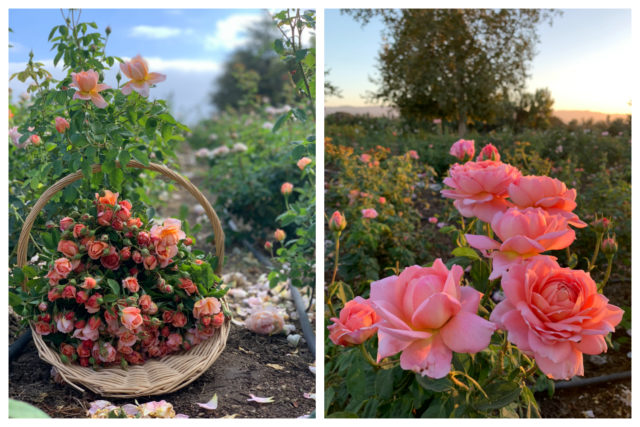 We adopted the method commercial rose growers use called “grafting” or “budding” to grow our collection of antique and rare roses. This allows for as many as 100 new plants to be born from a single mother plant since you’re only using the bud eyes on the stems.
We adopted the method commercial rose growers use called “grafting” or “budding” to grow our collection of antique and rare roses. This allows for as many as 100 new plants to be born from a single mother plant since you’re only using the bud eyes on the stems.
We purchased rootstock seedlings, grew them for several months and then began harvesting bud eyes from our mother plants and cuttings to graft them onto the rootstock. Once the bud eye is grafted onto the rootstock, growth from the graft should appear within a month. As soon as new growth appears, you have a new rose in the variety grafted onto the rootstock.
This technique is quick and while costly for labor, we produced thousands of new roses in one season. These are roses that are otherwise commercially unavailable and would take us years to find and propagate.
Erin: It looks like 2019 is going to be an incredible year for you. In addition to hosting your farm tours, what will you be up to?
Gracie: We have some pretty lofty goals for 2019. We will completely renovate our property except the rose fields, including our barn, building a new home, new offices and several acres of gardens. The goal is to make Grace Rose Farm a destination and beautiful location for editorials and retreats. It’s going to be a 2 to 3 year process, but we’re up for it!
Over the course of the past three years, I’ve received hundreds of emails from people looking to start their own rose farms, so we’re going to be holding a masterclass for aspiring and experienced rose growers in May. It feels a bit weird to already be teaching others about what we do and how we do it, but I really want to see others have the same success we’ve had, and there are many valuable things about growing roses on a large scale and running the business side that I can pass on. Most of the people attending already know how to grow roses, so we will focus heavily on the business side of farming. That’s where my 20 years of marketing have really helped our business develop into what it has!
We will be introducing an organic, luxury rose skincare line in 2019. I am a big skincare nut and have always dreamed of using my rose petals to create essential oils, serums, exfoliators and moisturizers. We don’t know of another American grown source of organic roses that are used in skincare, so we’re hopeful this new venture will be well received!
Our nursery will continue in 2019. We’re going to offer custom grafting for customers looking for roses but who don’t want to wait six months for plants. They will be able to order roses, we’ll take cuttings and graft their roses and then send their roses after several inches of new growth appear. We will still offer full size plants for those who don’t want the responsibility of newly grafted roses. We have over 250 varieties of rare and antique roses growing in our hoop houses. Those roses will be sprinkled about in the gardens we are designing so our property will be home to a beautiful, extensive collection of rare roses.
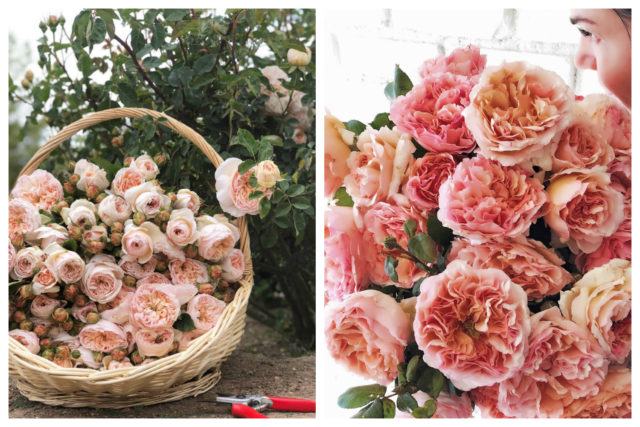
We also have received requests from people throughout our area to consult with them on rose garden design, so we’re offering full scale garden planning. So far we’re working with clients who want us to help them plan, source and install their roses or simply want help in pruning and winter care. We see this as a great direction for our business, and it really helps to keep me inspired to see others take joy in roses the way I do!
Finally, our biggest change, and you’re the first to know this, will be expanding into online retail sales of cut roses!
This has been a work in progress for our farm. Last year we set up an e-commerce site for florists to source our roses so we could learn how to integrate an online shop with our processes and procedures. We also worked on perfecting our packaging techniques, cold storage, shipping logistics and identified the rose varieties that would carry us into this new retail market.
I think a lot of people will ask why we are making this change because it sounds like a ton of work. Simply, the general public doesn’t know what real roses are. People deserve to have flowers that are healthy and sustainably grown. I feel it’s my obligation to educate American consumers on what a real rose is – a fragrant, high petaled beauty that fully opens to reveal itself and is as individual as our fingerprints.
The “what” of this new business took us some time to develop. I didn’t want to just sell my garden roses in the same way we sell them to florists (in bunches of 12). I needed to conceive a product that would be unique to us. We are excited to announce we have designed six garden rose bouquets in colors ranging from pastels to brights and in sizes from one dozen to three dozen. Our roses will be accompanied by locally sourced seasonal fresh greens, packaged and wrapped beautifully and tied off with velvet ribbon. Recipients of our bouquets will feel like they are receiving bridal bouquet quality and will have the pleasure of watching their roses open over the course of a week, something up until now, people have never been able to see unless they have roses in their own garden. Our bouquets are grown and sourced in the USA and even our boxes have been custom designed locally.
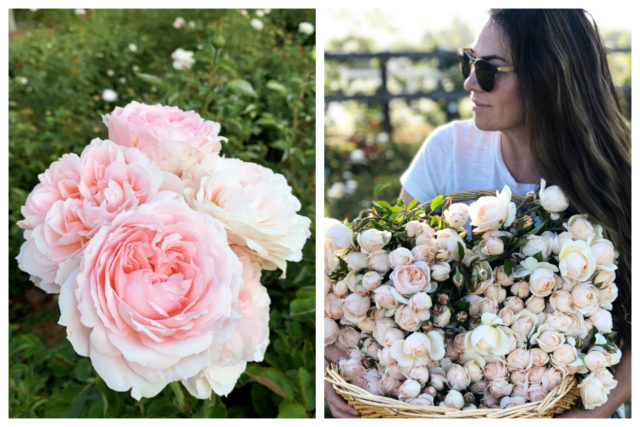 It’s hard to believe we started in our backyard three years ago and are now heading into a market dominated by FTD, Teleflora and 1-800-flowers, but I so believe our garden roses and the exquisite product we’re crafting for people are worthy of a national presence. People don’t know what they’re missing and it’s my mission to educate them! The past three years of growing, processing and shipping thousands of roses each week has educated us in ways we could never have guessed had we just tried to jump into retail immediately. We feel very confident as we move into this exciting new space and can’t wait to grow more roses!
It’s hard to believe we started in our backyard three years ago and are now heading into a market dominated by FTD, Teleflora and 1-800-flowers, but I so believe our garden roses and the exquisite product we’re crafting for people are worthy of a national presence. People don’t know what they’re missing and it’s my mission to educate them! The past three years of growing, processing and shipping thousands of roses each week has educated us in ways we could never have guessed had we just tried to jump into retail immediately. We feel very confident as we move into this exciting new space and can’t wait to grow more roses!
As for our floral design clients? We will continue to serve floral designers both locally and nationally and are planting more of their favorite roses. We will continue to have our booth in the Los Angeles Flower Market and will be open Monday through Saturday 5am to 9am.
Our handcrafted, luxury garden rose bouquets will be available at gracerosefarm.com starting in April and we will be taking orders for Mother’s Day. People can order our bouquets as a one time shipment/gift or subscribe for weekly, bi-weekly or monthly deliveries. Our handcrafted skincare items will be available for people to add to their orders so they can have the scent of our roses long after their bouquet. We will send you the very first of our rose bouquets in April!
Erin: Wow–what an exciting year ahead. I’m looking forward to seeing your roses this spring and following your progress on Instagram. Thank you for being open and sharing so much beauty with the world. I’m cheering for you and can’t wait for the day when I get to walk through your fields of roses.
To celebrate Valentine’s Day, I’m giving away a deluxe set of Grace Rose Farm’s rose-infused skincare products. For a chance to win, simply post a comment below. In your comment, please share a memory of getting or gifting roses (or other flowers). The deadline for entries is Friday, February 22nd.
UPDATE:
The giveaway is now closed. Congratulations to our winner, Katie Stemp!
Please note: If your comment doesn’t show up right away, sit tight, we have a spam filter that requires we approve comments before they are published.
Learn more about Grace Rose Farm here: Website
Instagram: @gracerosefarm
Facebook: @gracerosefarm

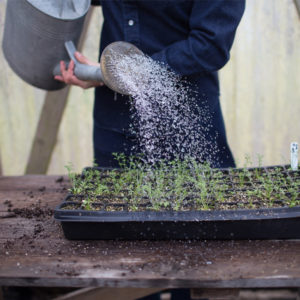

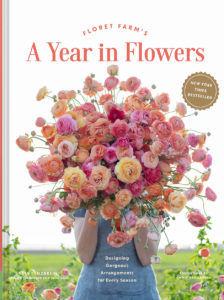
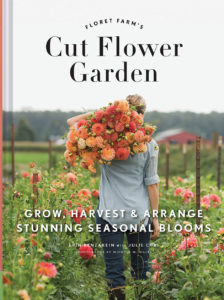


Megan Wilson on
Thanks for introducing Grace and some beautiful, new-to-me varieties. I was inspired and ordered rose plants today, so thank you for the tips!